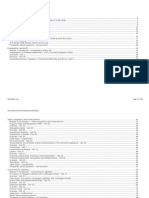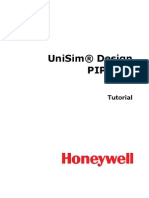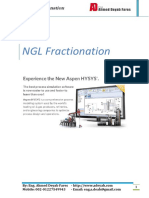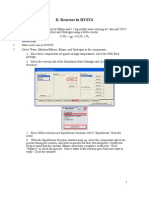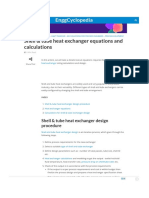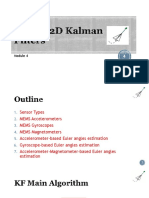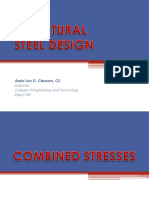Rating Heat Exchangers
Rating Heat Exchangers
Uploaded by
Syed Muzamil AhmedCopyright:
Available Formats
Rating Heat Exchangers
Rating Heat Exchangers
Uploaded by
Syed Muzamil AhmedCopyright
Available Formats
Share this document
Did you find this document useful?
Is this content inappropriate?
Copyright:
Available Formats
Rating Heat Exchangers
Rating Heat Exchangers
Uploaded by
Syed Muzamil AhmedCopyright:
Available Formats
Rating Heat Exchangers 1
1
Rating Heat Exchangers
1999 AEA Technology plc - All Rights Reserved
ADV 5_1.pdf
2 Rating Heat Exchangers
2
Workshop
A heat exchanger is a vessel that transfers heat energy from one process
stream to another. A common physical configuration for heat
exchangers is a shell and tube exchanger, where a bundle of tubes sits
inside a shell. There is no mixing of fluid between the shell and the
tubes.
Learning Objectives
In this workshop, you will learn how to:
Use the Heat Exchanger Simple Rating Method in HYSYS for
heat exchanger design
Determine if an existing heat exchanger will meet the process
specifications
Prerequisites
Before beginning this workshop, you need to know how to:
Install and converge simple Heat Exchangers
Understand the principles of Heat Exchanger design
Process Overview
4 Rating Heat Exchangers
4
Modelling Heat Exchangers
In this workshop, we will examine a gas to gas heat exchanger from a
Refrigerated Gas Plant. Heat exchangers are modelled in HYSYS using
one of three configurations:
Shell and Tube
Cooler/Heater
Liquified Natural Gas (LNG) exchanger
The Cooler/Heater operations are single-sided unit operations where
only one process stream passes through the operation. The LNG
Exchanger allows for multiple (more than two) process streams. A shell
and tube heat exchanger is a two-sided unit operation that permits two
process streams to exchange heat.
In this model, a shell and tube exchanger of given dimensions will be
rated to see if it will meet the requirements of the process.
Heat Exchanger Calculations
The calculations performed by the Heat Exchanger are based on energy
balances for the hot and cold fluids. The following general relation
defines the heat balance of an exchanger.
(M
cold
(H
out
-H
in
)
cold
-Q
leak
)-(M
hot
(H
in
-H
out
)
hot
-Q
loss
)=Balance Error
where: M = Fluid mass flow rate
H = Enthalpy
Q
leak
= Heat Leak
Q
loss
= Heat Loss
The Balance Error is a Heat Exchanger Specification which, for most
applications, will equal zero. The subscripts "hot" and "cold" designate
the hot and cold fluids, while "in" and "out" refer to the inlet and outlet.
Rating Heat Exchangers 5
5
The Heat Exchanger duty may also be defined in terms of the overall
heat transfer coefficient, the area available for heat exchange and the
log mean temperature difference:
Q = UA(LMTD)F
t
= M
hot
(H
in
-H
out
)
hot
-Q
loss
= M
cold
(H
out
-H
in
)
cold
-Q
leak
where: U = Overall heat transfer coefficient
A = Surface area available for heat transfer
LMTD = Log mean temperature difference
F
t
= LMTD correction factor
Log Mean Temperature Difference (LMTD)
The LMTD is calculated in terms of the temperature approaches
(terminal temperature differences) in the exchanger using the following
equation:
where:
The LMTD can be either terminal or weighted. This means that it can
be calculate over the exchanger as a whole (terminal) or over sections of
the exchanger (weighted). The need for this type of calculation is shown
below.
The following plot is a heat loss curve for a single phase stream. It
compares the temperatures of the process streams with the heat flow
over the entire length of the exchanger. For single phase streams, these
plots are linear.
LMTD
T
1
T
2
( T ln
1
T
2
)
----------------------------------- =
T
1
T
hot , out
T
col d, in
=
T
2
T
hot , in
T
cold, out
=
6 Rating Heat Exchangers
6
The following curve represents a superheated vapour being cooled and
then condensed. Note that it is not linear because of the condensation
that takes places inside the exchanger.
If the LMTD is calculated using the hot fluid temperatures at points A
and C, the result would be incorrect because the heat transfer is not
constant over the length of the exchanger. To calculate the weighted
LMTD:
1. Break the heat loss curve into regions at point B.
2. Calculate the terminal LMTD for each region.
3. Sum all of the LMTDs to find the overall LMTD.
HYSYS will do this automatically if the Heat Exchanger model is chosen
as Weighted. Therefore, if condensation or vaporization is expected to
occur in the exchanger, it is important that Weighted is chosen as the
model.
Rating Heat Exchangers 7
7
Heat Exchanger Specifications
As with all other unit operations in HYSYS, the Heat Exchanger is
assumed to adequately meet the process requirements. There are
several choices for specifications for the heat exchanger. The choices
are given here:
Temperature - The temperature of any stream attached to the
Heat Exchanger. The hot or cold inlet equilibrium temperature
may also be defined. The temperature difference between the
inlet and outlet between any two streams attached to the Heat
Exchanger can also be specified.
Minimum Approach - The minimum temperature difference
between the hot and cold stream at any point in the exchanger,
i.e. not necessarily at the inlet or outlet.
UA - The overall UA can also be specified. This specification
can be used to rate existing exchangers.
LMTD - The overall log mean temperature difference.
Pressure Drops - The pressure drops on both the shell and
tube sides on the exchanger are important specifications that
should not be ignored. If the pressure drops are not known
HYSYS may be able to estimate them.
Care must be taken when choosing specifications because it is possible
to select specifications that are either infeasible or impractical. This
may result in a Heat Exchanger that will not solve.
Specifications are added on the Specs page of the Heat Exchanger
Property view. Enough specifications must be added to ensure that the
Degrees of Freedom equals 0.
Typical specifications for most
heat exchangers are Pressure
Drops, and one of either,
Temperature, Minimum
Approach, Duty ,or UA.
8 Rating Heat Exchangers
8
Heat Exchanger Performance
A summary of the Heat Exchangers performance can be viewed on the
Details page of the Performance tab:
Heat exchangers are sometimes compared on the basis of UA values,
i.e., for a fixed surface area, what is the amount of heat (duty) that can
be exchanged?
1. Open the HYSYS case, A:\Gas-Gas.hsc on the disk that was
supplied with this module.
2. Double-click the Gas-Gas heat exchanger, and answer the
following questions.
What is the UA value of the Gas-Gas Exchanger?_________
What is the resulting minimum approach temperature if
the UA is fixed at 15 000 kJ/C-hr (8000 BTU/F-Hr)?
__________
What are the temperatures of streams Gas to Chiller and
Sales Gas?__________
Typically, heat exchangers are
solved using delta T minimum
approach and UA target
values.
Rating Heat Exchangers 9
9
Heat Exchanger Rating
The Simple Rating option can be chosen by selecting Simple Rating
from the Heat Exchanger Model drop down menu on the Parameters
page on the Design tab. Note that once this model is chosen, all
information on this page disappears. This is because with this type of
model the required information must be specified elsewhere.
Simple Rating Model
The some of the physical design specifications of an exchanger must be
supplied on the Sizing page of the Rating tab.
1. Firstly, select the Mode as Detailed or Basic. The type of
information that the rating routine requires depends on whether
Basic or Detailed is chosen on this page. This should be the first
step every time.
2. Next, specify the TEMA type to match the desired conditions.
10 Rating Heat Exchangers
10
For the Simple Rating model, the radio button selection in the Sizing
Data group will dictate the type of information shown at any given
moment. Each parameter will be defined later on in this module.
The radio buttons in the Sizing Data group include;
Overall - required information about the entire exchanger. Most
of the information entered here is used only in dynamic
simulations.
Shell - required information concerning the shell side of the
exchanger. All variables must be specified.
Tube - required information concerning the tube side of the
exchanger. All variables must be specified.
The TEMA Type is selected as part of the Overall sizing data. There are
three drop down lists which allow you to specify the geometry of the
front end stationary head type, the shell type and the rear end head
type for the exchanger. The following tables provide brief descriptions
for each designated TEMA Type letter. Drawings of the various TEMA
types can be found on page 11-4 of Perrys Chemical Engineers
Handbook, Sixth Edition.
TEMA - Front End Stationary Head Types
Any information inputted into
the Optional/Calculated
group will be used in the
calculations instead of HYSYS
calculated values.
TEMA Type Description
A Channel and Removable Cover
B Bonnet (Integral Cover)
C Channel Integral with TubeSheet and Removable Cover
(removable tube bundle only)
N Channel Integral with TubeSheet and Removable Cover
D Special High Pressure Closure
Rating Heat Exchangers 11
11
TEMA Shell Types
TEMA - Rear End Head Types
TEMA Type Description
E One Pass Shell
F Two Pass Shell with Longitudinal Baffle
G Split Flow
H Double Split Flow
J Divided Flow
K Kettle Type Reboiler
X Cross Flow
TEMA Type Description
L Fixed TubeSheet like A Stationary Head
M Fixed TubeSheet like B Stationary Head
N Fixed TubeSheet like N Stationary Head
P Outside Packed Floating Head
S Floating Head with Backing Device
T Pull Through Floating Head
U U-Tube Bundle
W Externally Sealed Floating TubeSheet
12 Rating Heat Exchangers
12
Simple Rating Parameters
Brief explanations are provided below for each Simple Rating
parameter. The parameters are categorized according to the radio
buttons in the Sizing Data group box. Most of these parameters are
only available when the mode is chosen as Detailed as opposed to
Basic.
Overall Information:
Tube Volume - the volume inside the tubes, used only in
dynamic simulations.
Shell Volume - the volume inside the shell, used only in
dynamic simulations.
Heat Trans. Area - the total area available for heat transfer,
calculated from the specified geometry.
Elevation - the height of the base of the exchanger, used only
in dynamic simulations.
Number of Tube Passes - the number of tube passes per
shell. Usually equal to 2*n, where n is the number of shells.
Orientation - the orientation of the exchanger, used only in
dynamic simulations.
TEMA Type - described earlier.
Shell Side Required Information:
Shells in Series - the number of shells in series.
Shells in Parallel - the number of shells in parallel.
Shell Diameter - can be specified or calculated from inputted
geometry.
Shell Fouling - the fouling factor on the shell side.
Baffle Type - a choice of single, double, triple, NTIW or grid.
Baffle Orientation - a choice between horizontal or vertical.
Baffle Cut (% Area) - the percent of the cross-sectional profile
unobstructed by the baffle.
Baffle Spacing - the distance between adjacent baffles.
Rating Heat Exchangers 13
13
Tube Side Required Information:
Tube OD - the outside diameter of the tubes.
Tube ID - the inside diameter of the tubes.
Tube Thickness - usually calculated from the two numbers
inputted above.
Tube Length - the tube length per shell (one side for a U-tube).
Tubes Per Shell - provide the total number of holes per shell;
HYSYS will determine the appropriate number of tubes based
on the input number of tube passes.
Tube Pitch - the shortest centre to centre distance between 2
tubes
Tube Layout Angle - a choice between four different
configurations.
Tube Fouling - the tube side fouling factor.
Tube Thermal Conductivity - the thermal conductivity of the
tubes, used in determined the overall heat transfer coefficient,
U.
Tube Wall Cp, and Tube Wall Density - two physical
properties of the tube material, used only in dynamics.
14 Rating Heat Exchangers
14
More Information about the exchanger can be entered on the
Parameters page of the Ratings tab.
If your are entering actual size information about the exchanger and
want HYSYS to calculate heat transfer coefficients and pressure drops,
use the drop-down bar to specify the Heat Transfer Coefficient
Calculation as Shell & Tube, also specify both the Shell Pressure Drop
Calculator and Tube Pressure Drop Calculator as Shell & Tube DP
Calc. This will allow HYSYS to use the specified exchanger geometry
and correlations to determine the shell and tube side pressure drops as
well as the heat transfer coefficients on both sides of the exchanger.
The Simple Rating model uses generalized correlations
for heat transfer coefficients and pressure drop. These
correlations are suitable for approximate results in most
cases but may not be valid for every exchanger. For more
accuracy, a rigorous model may be required. Please
contact your Hyprotech representative for a list of
available third party heat exchanger packages that are
compatible with HYSYS through OLE Extensibility.
Rating Heat Exchangers 15
15
Exploring with the Simulation
You are asked to find a heat exchanger that will serve as the Gas-Gas
exchanger. However, since you are on a very strict budget, you can only
consider used equipment. A heat exchanger has been found in the
surplus supply of a nearby plant. If the critical process parameter is to
maintain a Sales Gas temperature of at least 10 C (50 F), can this heat
exchanger be used for the Gas-Gas service? The surplus exchanger has
been thoroughly cleaned. The TEMA definition of this exchanger is
A,E,L. The pressure drops on both sides of the exchanger should be
deleted; this will allow HYSYS to calculate these parameters. The
dimensions of the exchanger are given here:
Tube Length = 1.5 m
Number of tubes = 300
Tube Pitch = 30 mm
Baffle Type = Double
Baffle Orientation = Vertical
Baffle Cut (% Area) = 15 %
Baffle spacing = 100 mm
All other parameters are the HYSYS default values
Use the Simple Rating mode in HYSYS to determine if the exchanger is
suitable.
Previous experience has shown you that after about six months in
operation, the exchanger becomes fouled and the fouling factor for
both shell-side and tube-side is 0.1 C-h-m
2
/kJ.
What is the temperature of the Sales Gas using this
exchanger? __________
What will the temperature of the Sales Gas be after 6
months of service? __________
Will this exchanger be adequate after 6 months of service?
__________
Save your case!
16 Rating Heat Exchangers
16
Challenge
Why was the Recycle needed in this Flowsheet?
For an interesting challenge, remove the recycle operation and stream
1. Connect the stream LTS Vap in place of stream 1, and try to solve the
exchanger. You will have to add just one more specification. Which one?
Well, here are two hints. It is on the Parameters page, and it was a value
that was used before but was not needed after the exchanger was rated.
Another Good Question
Look at the Temperature vs Heat Flow plot on the Plots page of the
Performance tab. It was mentioned earlier that condensation inside an
exchanger may cause one of these lines to be bent, or non-linear.
However, it can be seen on this plot that the lines here are linear.
The UA for this exchanger is defined from the physical parameters of
the exchanger. The duty is then calculated as the product of the UA and
the terminal LMTD. It is not necessary for HYSYS to examine individual
intervals within the exchanger; therefore, the lines are drawn as linear.
Which specification did you add? __________
Why was this value necessary? __________
What is the vapour fraction of the Gas to Chiller
stream? __________
Does condensation occur on the tube side of this
exchanger? __________
Why are both lines linear when they "should" be
bent? __________
You might also like
- Heat Exchangers in AspenDocument30 pagesHeat Exchangers in AspenMicheal Brooks33% (3)
- Aspen Energy Analyzer TutorialDocument101 pagesAspen Energy Analyzer TutorialMcn Serg100% (3)
- Determination of OD Cooling System Parameters Based On Thermal Modeling of Power Transformer WindingDocument12 pagesDetermination of OD Cooling System Parameters Based On Thermal Modeling of Power Transformer Windingmpu682No ratings yet
- Republic of Indonesia vs. VinzonDocument3 pagesRepublic of Indonesia vs. VinzonRomielyn Macalinao100% (1)
- Acca IfrsDocument109 pagesAcca Ifrsesam5278No ratings yet
- Model A Refrigerated Gas Plant Workshop: ObjectiveDocument25 pagesModel A Refrigerated Gas Plant Workshop: Objectivemiri-256No ratings yet
- AspenHYSYS Dynamics ADocument21 pagesAspenHYSYS Dynamics ANoyon NoyonNo ratings yet
- Aspen HySys Dynamic ModelingDocument223 pagesAspen HySys Dynamic Modelingi786zzyNo ratings yet
- 01 Getting StartedDocument32 pages01 Getting StartedSufyan KhanNo ratings yet
- Hysys Workbook Part-1: By: Eng. Ahmed DeyabDocument23 pagesHysys Workbook Part-1: By: Eng. Ahmed Deyabahmed atwaNo ratings yet
- How To Navigate To Aspen HYSYS V8Document20 pagesHow To Navigate To Aspen HYSYS V8Ahmad DeyabNo ratings yet
- Atmospheric Crude Column 1Document20 pagesAtmospheric Crude Column 1jparedanilNo ratings yet
- Hysys - Pressure Flow TheoryDocument18 pagesHysys - Pressure Flow Theoryramosgeneralesbazar100% (3)
- 04 ColumnDynamicsDocument18 pages04 ColumnDynamicsabhmarsNo ratings yet
- 04 NGLFractionationTrainDocument20 pages04 NGLFractionationTraingerbasio100% (1)
- Pressure Relief Dynamics Aspen PlusDocument18 pagesPressure Relief Dynamics Aspen Plusac2475No ratings yet
- Hysys WorkbookDocument23 pagesHysys WorkbookDaniloNo ratings yet
- C 03 RefrigeratedGasPlantDocument20 pagesC 03 RefrigeratedGasPlantShariq KhanNo ratings yet
- 08 ColumnPressureRelief PDFDocument10 pages08 ColumnPressureRelief PDFtaeebNo ratings yet
- Pipesys TutorialDocument62 pagesPipesys TutorialNatalia Prieto JimenezNo ratings yet
- Aspen MUSE GettingstartedDocument27 pagesAspen MUSE GettingstartedSurya Budi WidagdoNo ratings yet
- TUTORIAL DE COMPRESI Ôn - HYSYS PDFDocument18 pagesTUTORIAL DE COMPRESI Ôn - HYSYS PDFShirley Hernandez JimenezNo ratings yet
- EDR Plate Exchanger PDFDocument8 pagesEDR Plate Exchanger PDFMarta VidiellaNo ratings yet
- Advanced Hysys Course PSVDocument40 pagesAdvanced Hysys Course PSVEbby Onyekwe100% (2)
- Hysys TascDocument10 pagesHysys TascMariano PodestáNo ratings yet
- Modeling and Simulation of A Distillation Column Using ASPEN PLUS Libre PDFDocument9 pagesModeling and Simulation of A Distillation Column Using ASPEN PLUS Libre PDFmehul10941100% (1)
- Dyn 006H DepressuringDocument14 pagesDyn 006H DepressuringNicandroGonzalesNo ratings yet
- HYSYS - Vba - ExcelDocument314 pagesHYSYS - Vba - ExcelRodrigo RiveraNo ratings yet
- AspenPIPESYSV7 2 TutorialDocument66 pagesAspenPIPESYSV7 2 TutorialAmbuja SharmaNo ratings yet
- 1.3.5 PreHeat TrainDocument20 pages1.3.5 PreHeat TrainflowealthNo ratings yet
- NGL Fractionation Using HYSYSDocument30 pagesNGL Fractionation Using HYSYSAhmad Deyab100% (3)
- C3loop Adeyab PDFDocument21 pagesC3loop Adeyab PDFAntHony K-ianNo ratings yet
- D. Reactions in HYSYS - NewDocument12 pagesD. Reactions in HYSYS - NewRafael FaioliNo ratings yet
- HYSYS Training 2013Document27 pagesHYSYS Training 2013Kokil JainNo ratings yet
- 3.1.4 Linking Excel and HYSYS - 1 PDFDocument14 pages3.1.4 Linking Excel and HYSYS - 1 PDFLara ArinelliNo ratings yet
- Korf Hydraulic ReportDocument10 pagesKorf Hydraulic ReportMuthuKumar ArunachalamNo ratings yet
- Use of Dynamic Simulation To ConvergeDocument8 pagesUse of Dynamic Simulation To ConvergeneftNo ratings yet
- Aspen HYSYS Task Sheet PDFDocument8 pagesAspen HYSYS Task Sheet PDFIbrahim Ben AmeurNo ratings yet
- Assay BachaqueroDocument12 pagesAssay BachaqueroGinis MrcNo ratings yet
- AFHEWebinar29-Nov-2011 - Final Fired HeaterDocument26 pagesAFHEWebinar29-Nov-2011 - Final Fired HeaterAmit Goel100% (3)
- A-Extensions in HYSYSDocument4 pagesA-Extensions in HYSYSSyed Muzamil AhmedNo ratings yet
- AspenFLARENET2006 StartDocument61 pagesAspenFLARENET2006 Startapi-3750488100% (1)
- Advanced Recycle Operations 1Document44 pagesAdvanced Recycle Operations 1Kajer quemarNo ratings yet
- Column SizingDocument16 pagesColumn SizingSyed Muzamil Ahmed100% (9)
- Event Scheduler & Spreadsheet 1Document18 pagesEvent Scheduler & Spreadsheet 1Kajer quemarNo ratings yet
- Hydroprocessing for Clean Energy: Design, Operation, and OptimizationFrom EverandHydroprocessing for Clean Energy: Design, Operation, and OptimizationNo ratings yet
- AIChE Equipment Testing Procedure - Trayed and Packed Columns: A Guide to Performance EvaluationFrom EverandAIChE Equipment Testing Procedure - Trayed and Packed Columns: A Guide to Performance EvaluationNo ratings yet
- 1.3.9 Rating Heat ExchangerDocument18 pages1.3.9 Rating Heat ExchangerMelva NainggolanNo ratings yet
- WWW Enggcyclopedia Com 2019 05 Shell Tube Heat Exchanger EquationsDocument8 pagesWWW Enggcyclopedia Com 2019 05 Shell Tube Heat Exchanger EquationspriyankaNo ratings yet
- Heat Exchanger Lectures CompleteDocument72 pagesHeat Exchanger Lectures CompletehananNo ratings yet
- Heat Transfer: EctureDocument20 pagesHeat Transfer: EctureaymaNo ratings yet
- New Microsoft Word Document 4.1Document19 pagesNew Microsoft Word Document 4.1prashantmaukaNo ratings yet
- Meshkat Design Heat ExchangerDocument36 pagesMeshkat Design Heat ExchangerjdedfvNo ratings yet
- Design Process PDFDocument19 pagesDesign Process PDFmithuwanNo ratings yet
- Test de RadiadorDocument10 pagesTest de RadiadorOmar Reinoso TigreNo ratings yet
- Heat ExchangersDocument19 pagesHeat ExchangersRhamadanny OmarNo ratings yet
- Introduction To Aspen Plus 2013 Tutorial VDocument77 pagesIntroduction To Aspen Plus 2013 Tutorial VsyafieqNo ratings yet
- 4 Heat Exchanger - ProcessdesignDocument12 pages4 Heat Exchanger - ProcessdesignsanyuktaNo ratings yet
- ASPEN Exercise - Heat ExchangersDocument4 pagesASPEN Exercise - Heat ExchangersRomain LefèbvreNo ratings yet
- Module#3-Heat ExchangersDocument19 pagesModule#3-Heat ExchangersLa Casa JordanNo ratings yet
- Bio EthanolDocument303 pagesBio EthanolSyed Muzamil Ahmed100% (2)
- A-Extensions in HYSYSDocument4 pagesA-Extensions in HYSYSSyed Muzamil AhmedNo ratings yet
- Compressor CurvesDocument10 pagesCompressor CurvesSyed Muzamil Ahmed100% (1)
- The HYSYS SpreadsheetDocument10 pagesThe HYSYS SpreadsheetSyed Muzamil AhmedNo ratings yet
- 2 Stage CompressionDocument18 pages2 Stage CompressionSyed Muzamil Ahmed100% (3)
- Using Calc LevelsDocument16 pagesUsing Calc LevelsSyed Muzamil Ahmed100% (1)
- Adv 8 1Document10 pagesAdv 8 1Micu Ionut BogdanNo ratings yet
- Compressor and Pump CurvesDocument14 pagesCompressor and Pump CurvesSyed Muzamil AhmedNo ratings yet
- Reactions With HYSYSDocument16 pagesReactions With HYSYSSyed Muzamil AhmedNo ratings yet
- The HYSYS SpreadsheetDocument16 pagesThe HYSYS SpreadsheetSyed Muzamil Ahmed67% (6)
- Column SizingDocument16 pagesColumn SizingSyed Muzamil Ahmed100% (9)
- Module 2: Types of Information SystemsDocument80 pagesModule 2: Types of Information SystemsGeorge OkemwaNo ratings yet
- Ss Material List 2Document10 pagesSs Material List 2stejakumarsam123No ratings yet
- Account StatementDocument39 pagesAccount StatementSun SivathaNo ratings yet
- Good Agricultural Practices For Sugarcane: Thai Agricultural Standard TAS 5902-2010Document29 pagesGood Agricultural Practices For Sugarcane: Thai Agricultural Standard TAS 5902-2010Nkem Joseph-PalmerNo ratings yet
- AMMAR AKL Electric ResumeDocument4 pagesAMMAR AKL Electric ResumeENG AMMARNo ratings yet
- Traversing (NICE)Document33 pagesTraversing (NICE)prasitagnihotriNo ratings yet
- Japanese Subtitles For AnimeDocument3 pagesJapanese Subtitles For AnimeRhenier Ruiz GustiloNo ratings yet
- Giglio Letter To Local Law EnforcementDocument4 pagesGiglio Letter To Local Law EnforcementAlbuquerque JournalNo ratings yet
- Netflow Analysis CiscoDocument20 pagesNetflow Analysis Ciscohola amigoNo ratings yet
- General: Cessna Citation XLS - Flight ControlsDocument4 pagesGeneral: Cessna Citation XLS - Flight ControlsMohammed MilatNo ratings yet
- Project-Report SampleDocument59 pagesProject-Report SampleNile SethNo ratings yet
- EPI 2.07 Community DiagnosisDocument3 pagesEPI 2.07 Community DiagnosisJoher MendezNo ratings yet
- Miller Axel ANSYS 2013 DetroitDocument26 pagesMiller Axel ANSYS 2013 DetroitSrashmiNo ratings yet
- Srs Event Management System PDF FreeDocument4 pagesSrs Event Management System PDF FreeShubham YadavNo ratings yet
- Working With FunctionsDocument11 pagesWorking With Functionsdalefav101No ratings yet
- Enterprise Resource Planning (ERP)Document15 pagesEnterprise Resource Planning (ERP)Ankita BoradeNo ratings yet
- Module 4 - 1D Kalman Filters For OrientationDocument24 pagesModule 4 - 1D Kalman Filters For OrientationYonas GhiwotNo ratings yet
- Manchester Is My Planet The Climate ChangeDocument33 pagesManchester Is My Planet The Climate Changeapi-21744395No ratings yet
- Financial Management Part 2: Lecturer: Dr. Ann Downer, EddDocument2 pagesFinancial Management Part 2: Lecturer: Dr. Ann Downer, EddMark Anthony EllanaNo ratings yet
- Revalidation FormatDocument2 pagesRevalidation FormatVipin KumarNo ratings yet
- Transmitter and Smart TransmitterDocument57 pagesTransmitter and Smart TransmitterBHAGSEN PARVATNo ratings yet
- Measures of Central Tendency and DispersionDocument1 pageMeasures of Central Tendency and Dispersionyathsih24885No ratings yet
- Chapter 3 Transportation and Assignment ProblemDocument33 pagesChapter 3 Transportation and Assignment ProblemfekadeNo ratings yet
- 91d2dOM PPT-8 (Aggregate Planning) Part IIDocument10 pages91d2dOM PPT-8 (Aggregate Planning) Part IIAdityaVikramBhadauriaNo ratings yet
- Chapter 08 - Combined StressesDocument16 pagesChapter 08 - Combined StressesJohn Eduard GallegoNo ratings yet
- Annex I and II - Application Form For Registration of A Foreign Company and GuidlineDocument6 pagesAnnex I and II - Application Form For Registration of A Foreign Company and GuidlineWaqasskhanNo ratings yet
- A050 Galaxy Manual PDFDocument16 pagesA050 Galaxy Manual PDFFrancisco M. Ramos0% (1)
- Past SimpleDocument5 pagesPast Simplelavica13No ratings yet




